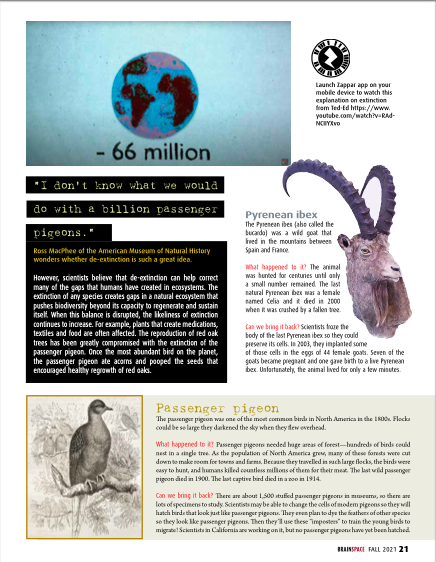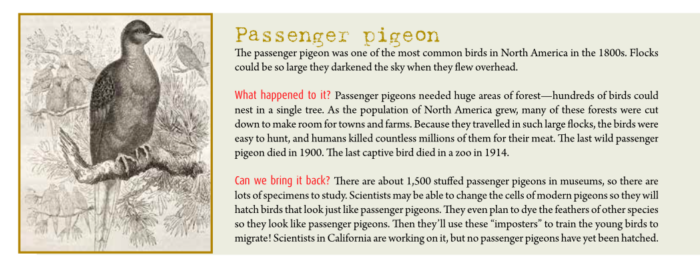
Historic animals that could be part of our future again


What would it be like to watch a wooly mammoth rasie it’s trunk? Or to see a million passenger pigeons fly over your head? Nobody alive today has ever seen these sights – but your grandchild might. Bringin extinct animals back to life used to be nothing more than a crazy-sounding idea. But in 2021, a group of scientists got together to talk about whether it might actually be possible. It turns out “de-extinction” may be only decades away. Here are. few animals that may soon return from the dead.
THE WOOLY MAMMOTH
These hairy cousins of elephants were hunted by early humans for their meat, bones, and skin. Most mammoth species were extinct by the end of the Ice Age, about 10,000 years ago. However, the last woolly mammoths survived until about 4,000 years ago. That means they were still walking around centuries after the Egyptians built the pyramids! They probably died out because of climate change and over-hunting by humans. Because mammoths lived during the Ice Age, they often froze after they died. Scientists have discovered many frozen bodies that still have fur, skin, and muscle. In 2013, they even found a wooly mammoth that still had blood! It might be possible to clone a mammoth with the help of a modern elephant mother. One Canadian scientist says we may be able to do it withing 30 to 50 years.
GASTRIC-BROODING FROG
There has never been another animal like the cool-but-creepy gastric-brooding frog. The females swallowed their own eggs and the babies grew inside their mother’s stomach. When the tadpoles became fully formed frogs, the mother “barfed” them out of her mouth! These frogs were discovered in Australia int he early 1970s, but within ten years they were extinct. No one is quite sure why: probably due to habitat loss, pollution, and disease. Although scientists had only a few years to study these frogs, they did collect several specimens and stored them in freezers. In 2021, biologists in Australia came close to bringing these amazing amphibians back to life. First, they collected cells from the frozen gastric-brooding frogs and planted them into eggs of different frog species. The eggs developed for a few days but eventually died.
PYRENEAN IBEX
The Pyrenean ibex (also called the bucardo) was a wild goat that lived in the mountains between Spain and France. The animal was hunted for centuries until only a small number remained. The last natural Pyrenean ibex was a female named Celia and it died in 2000 when it was crushed by a fallen tree. Scientists froze the body of the last Pyrenean ibex so they could preserve its cells. In 2003, they implanted some of those cells in the eggs of 44 female goats. Seven of the goats became pregnant an done gave birth to a live Pyrenean ibex. Unfortunately, the animal lived for only a few minutes.

ROSS MACPHEE of the American Museum of Natural History wonders whether de-extinction is such a great idea. However, scientists believe that de-extinction can help correct many of the gaps that humans have created in ecosystems. The extinction of any species creates gaps in a natural ecosystem that pushes biodiversity beyond its capacity to regenerate and sustain itself. When this balance is disrupted, the likeliness of extinction continues to increase. For example, plants that create medications, textiles, and food are often affected. The reproduction of red oak trees has been greatly compromised by the extinction of the passenger pigeon. Once the most abundant bird on the planet, the passenger pigeon ate acorns and pooped the seeds that encouraged healthy regrowth of red oaks.

